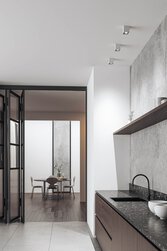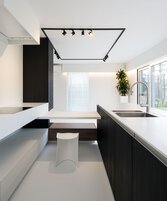Kitchen lighting
LOOKS YUMMY
People eat, laugh, celebrate, and philosophise for hours in the kitchen. The kitchen therefore deserves special attention when planning lighting. Work surfaces should be well-illuminated and provide a bright working light. A mix of spotlights and decorative lights create a pleasant atmosphere around the dining area.
This is how you do it
Do's and Dont's in kitchen lighting
Provide functional lighting above work areas. Choose lighting that evenly illuminates the work surface.

Think about the layers of lighting. Add ambience and accents in addition to functional lighting (task lighting). This reduces unwanted shadows and gives the kitchen more depth. Work with multiple light points. This counteracts too little light and shadow on the work surfaces. When using pendant lights above the work surface, also pay attention to the installation height. If you do not hang pendant lights too low, there is a risk that visual comfort will be restricted or you will be blinded.
Place accent lighting in front of the cabinets. Not only does it add atmosphere to your kitchen, it also ensures that enough light falls into the cupboard when it is opened. Coordinate furniture and lighting by matching the lights to the layout of the cabinets. When using surface-mounted spotlights, make sure that the cabinet can also be opened. Do not mount spotlights too far away from the cabinet. Place them 20 to 30 cm away from the cabinet so that you are not standing in your own shadow when you open the cabinet. Provide lighting in or under the shelves. This avoids unwanted shadows.
Choose variable lighting. You can transform the active kitchen into an atmospheric place to eat by dimming. After all, the kitchen is often the heart of the home. Don't just use simple on/off switches. Use dimmable solutions to create the right atmosphere in the kitchen.











































